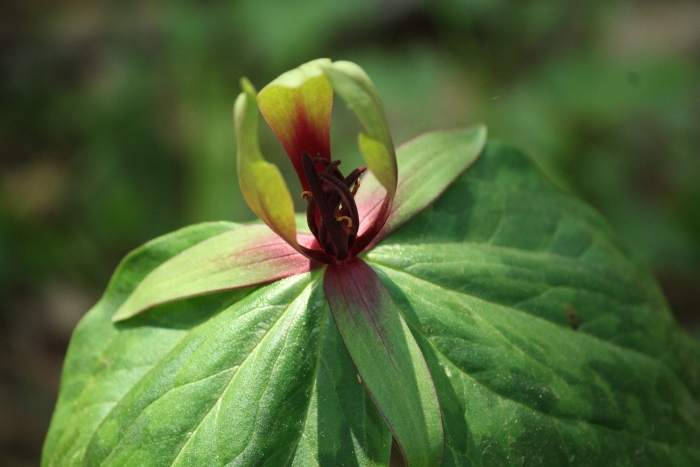Ozark Trillium
(Trillium viridescens)
Ozark Trillium (Trillium viridescens)
/
/

mayfly1963
CC BY 4.0
Image By:
mayfly1963
Recorded By:
Copyright:
CC BY 4.0
Copyright Notice:
Photo by: mayfly1963 | License Type: CC BY 4.0 | License URL: http://creativecommons.org/licenses/by/4.0/ | Rights Holder: mayfly1963 | Publisher: iNaturalist | Date Created: 2016-04-09T12:12:08-07:00 |
























Estimated Native Range
Summary
Trillium viridescens, commonly known as Ozark trillium or tapertip wakerobin, is a perennial herb native to the understory of rich, deciduous forests in the Ozark Mountains and surrounding regions, including parts of Arkansas, Missouri, Oklahoma, Kansas, Texas, and Louisiana. It typically grows to a height of about 2 feet (60 cm). The plant is notable for its striking early spring blooms, which appear from early April to mid-May. The flowers feature unique bi-colored petals that are purplish near the base, transitioning to green towards the tips, and are quite showy, attracting early pollinators.
Ozark trillium is appreciated for its ornamental value, particularly its distinctive flowers that herald the arrival of spring. It is used in shade gardens, woodland plantings, and naturalized areas where it can form attractive colonies over time. In cultivation, it requires moist, well-drained soil rich in organic matter, mimicking its native forest floor habitat. It prefers part shade to full shade conditions and is relatively low-maintenance once established. However, it is important to note that Trillium species can be slow to establish and may take several years to flower when grown from seed. While generally pest-free, they can suffer from slug damage. Additionally, Trilliums should not be harvested from the wild due to their slow reproductive cycle and the risk of depleting natural populations.CC BY-SA 4.0
Ozark trillium is appreciated for its ornamental value, particularly its distinctive flowers that herald the arrival of spring. It is used in shade gardens, woodland plantings, and naturalized areas where it can form attractive colonies over time. In cultivation, it requires moist, well-drained soil rich in organic matter, mimicking its native forest floor habitat. It prefers part shade to full shade conditions and is relatively low-maintenance once established. However, it is important to note that Trillium species can be slow to establish and may take several years to flower when grown from seed. While generally pest-free, they can suffer from slug damage. Additionally, Trilliums should not be harvested from the wild due to their slow reproductive cycle and the risk of depleting natural populations.CC BY-SA 4.0
Plant Description
- Plant Type: Herb, Bulb
- Height: 1-1.5 feet
- Width: 0.5-1 feet
- Growth Rate: Slow
- Flower Color: Green, Brown
- Flowering Season: Spring
- Leaf Retention: Deciduous
Growth Requirements
- Sun: Part Shade, Full Shade
- Water: Medium
- Drainage: Medium
Common Uses
Low Maintenance
Natural Habitat
Rich, deciduous forest understories in the Ozark Mountains and surrounding regions
Other Names
Common Names: Green Trillium, Tapertip Wakerobin, Ozark Trillium
Scientific Names: , Trillium viridescens, Trillium sessile var. nuttallii, Trillium sessile var. viridescens, Trillium stenanthes,
GBIF Accepted Name: